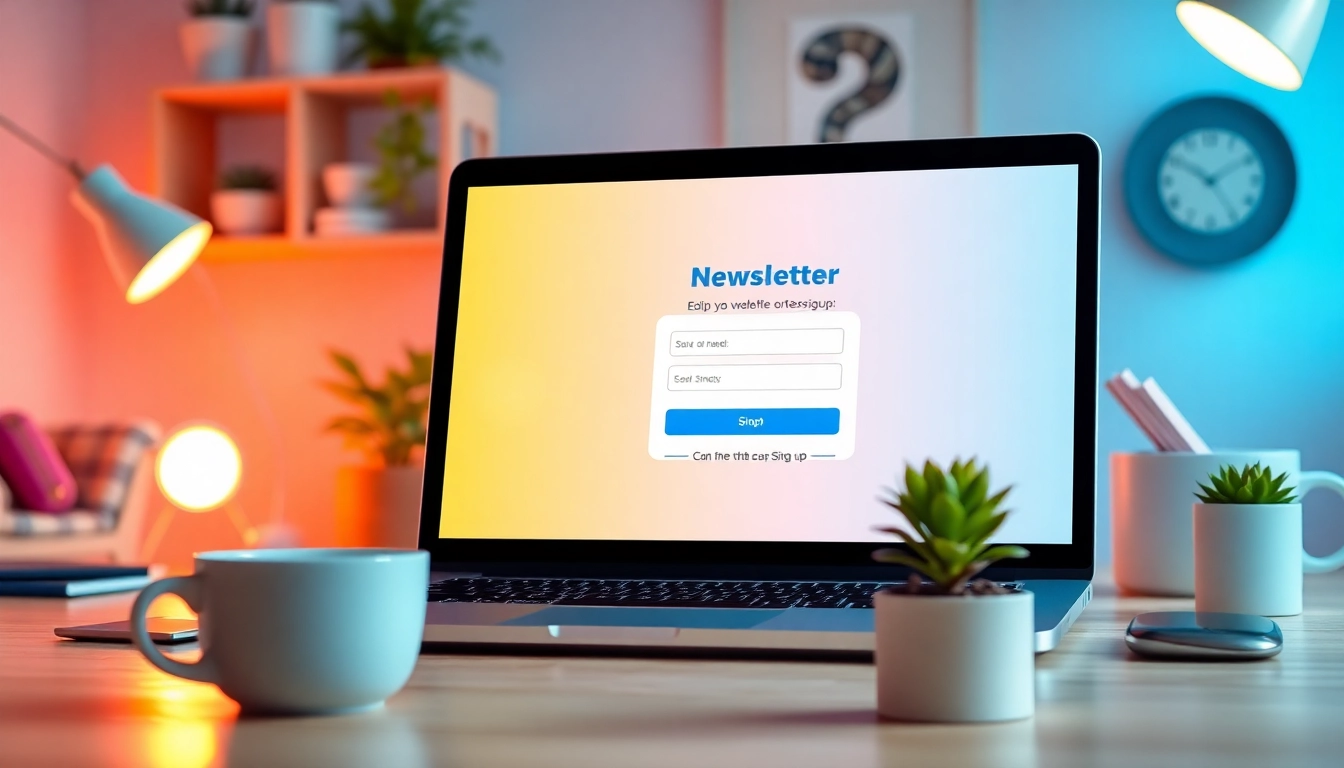Understanding Newsletter Signup: What You Need to Know
In the digital age, the significance of effective communication cannot be understated. One of the most powerful tools that businesses can leverage to ensure this communication is through newsletter signup. This mechanism allows brands to maintain consistent contact with their customers, provide valuable insights, and foster loyalty. However, a successful newsletter signup strategy involves understanding its importance, the communication benefits it offers, and dispelling common misconceptions associated with it.
The Importance of Email Marketing
Email marketing remains one of the most effective channels for reaching potential customers, boasting an average return on investment (ROI) of $42 for every dollar spent. This effectiveness can largely be attributed to the ability to deliver personalized content directly to an individual’s inbox, thus enhancing conversion rates and customer engagement. As people increasingly value their email privacy, acquiring email signups through newsletters represents a proactive approach to building a loyal customer base, allowing brands to craft targeted messages that resonate with their audience’s interests and preferences.
How Newsletter Signups Enhance Communication
The ability to reach your audience through email serves as a robust communication channel, unlike more passive methods such as social media or advertisements. A newsletter enables brands to share relevant content, updates, promotions, and educational information directly with subscribers. Moreover, it cultivates a sense of exclusivity, making subscribers feel valued and informed, thus nurturing a deeper relationship over time.
Common Misconceptions About Newsletter Signup
Many businesses operate under the misconception that newsletter signups result in spam complaints and low conversion rates. However, with the right strategies, companies can counteract these concerns. Educating your audience on the value of your newsletter, coupled with a transparent signup process, can lead to a solid subscriber list comprised of engaged readers who genuinely appreciate the content provided.
Best Practices for Effective Newsletter Signup Forms
Crafting an appealing newsletter signup form is fundamental to a successful email marketing strategy. Implementing best practices helps optimize your signup processes to convert visitors into valued subscribers.
Strategic Placement and Design Elements
The location and design of your signup form play a critical role in encouraging signups. Common design elements that attract signups include:
- Above the fold: Place the signup form prominently on your site, ideally above the fold. This ensures visibility as visitors first land on your page.
- Pop-ups: When executed correctly and timed well, pop-up forms can be highly effective. They capture attention without overwhelming the user experience.
- Incorporating visuals: Use eye-catching images or colors to draw attention to the signup form while maintaining alignment with your brand.
- Minimalist design: Keep forms simple and free of clutter. Fewer fields increase the likelihood of completing the signup process.
Crafting Compelling CTAs for Newsletter Signup
A Call to Action (CTA) serves as the driving force behind conversions. Effective CTAs should be:
- Action-oriented: Use verbs that prompt action, such as “Subscribe Now” or “Join Our Community.”
- Benefit-focused: Clearly articulate the value received from signing up. For instance, “Get exclusive insights and promotions directly to your inbox.”
- Contrasting colors: Ensure the CTA button stands out against the background, making it easily identifiable.
Incentives That Drive Signups
Offering incentives can significantly boost newsletter signup rates. Consider:
- Exclusive content: Provide subscribers access to valuable resources, such as eBooks, whitepapers, or case studies.
- Discounts and offers: Incentivize signups with tangible rewards, like discounts, free trials, or promotional offers.
- Contests and giveaways: Run engaging promotions that encourage participation and sharing.
Advanced Strategies for Maximizing Newsletter Signups
Once the basics are down, it’s time to implement advanced strategies that can take your newsletter signup process to the next level.
Segmentation: Tailoring Content to Your Audience
Not all subscribers are alike. By segmenting your audience based on interests, preferences, or behaviors, you can create tailored content that resonates with specific groups. This can include:
- Interest-based segments: Customize newsletters based on subscriber interests—be it promotions, resources, or industry news.
- Behavioral triggers: Send personalized follow-ups based on interaction history, such as past purchases or previously opened emails.
Segmenting your audience can enhance engagement and build relationships, leading to improved retention rates and decreased unsubscribe rates.
Utilizing Social Proof and Testimonials
Displaying testimonials or showcasing the number of existing subscribers can instill trust and credibility. Consider including:
- User testimonials: Incorporate authentic reviews from current subscribers that highlight the value of the newsletter.
- Subscriber counts: Showcasing a large number of existing subscribers can foster trust and prompt others to join.
A/B Testing: Optimizing Signup Forms
Regularly A/B testing different elements of your signup forms can lead to insights that enhance conversion rates. Test:
- Form length: Experiment with varying lengths of the signup form to find the optimal balance between required information and ease of use.
- CTA wording and color: Different phrases or colors may attract more clicks; it’s beneficial to assess multiple options.
- Incentives: Evaluate which incentives resonate more with your audience by analyzing signup rates caused by different offers.
Examples of Successful Newsletter Signup Approaches
Examining successful newsletter signup approaches sheds light on effective practices that can be emulated or adapted. The strategies can vary significantly across industries, yet several principles hold true.
Analysis of Top Brands’ Signup Forms
Prominent brands often lead the way in best practices. Here are notable examples:
- Mailchimp: Demonstrates a clean design, appealing visuals, segmented user options, and effective CTAs in their signup process.
- HubSpot: Utilizes engaging landing pages that outline benefits and features, clearly illustrating the advantages of subscribing to their newsletter.
Learning from Competitors: What Works?
Constantly observing competitors allows you to glean insights into what works within your sector. Understand:
- Form placement: Compare where competitors place their forms and test similar strategies.
- Offer types: Identify which incentives are most effective within your niche and innovate your approach accordingly.
Innovative Designs That Captivate Users
Winning designs do not just rely on functionality but also creativity. Consider incorporating:
- Interactive elements: Use gamification or polls within your signup forms to engage users actively.
- Dynamic content: Implement forms that can change based on user input or behavior.
Measuring the Success of Your Newsletter Signup Efforts
Consistent performance measurement is essential to refining newsletter signup strategies and maximizing effectiveness.
Key Performance Indicators to Track
To analyze the performance of your newsletter signup strategy, monitor the following KPIs:
- Signup conversion rate: The percentage of website visitors that complete the signup process provides a clear measure of effectiveness.
- Unsubscribe rate: A high unsubscribe rate can indicate that the content delivered isn’t resonating with your audience.
- Engagement metrics: Analyze metrics such as open rates, click-through rates, and overall engagement levels with your newsletters.
Assessing Audience Engagement Through Analytics
Leverage analytical tools to gain insights into audience behavior. Tools like Google Analytics can offer valuable data, allowing you to understand:
- User demographics: Identify who your subscribers are, helping to segment your audience effectively.
- Behavior on site: Analyze how users interact with your forms, including point of exit to refine your approach.
Adapting Strategies Based on Feedback
Regular feedback can provide insights into your audience’s preferences and pain points. Consider:
- Surveys: Periodically send out surveys to current subscribers to gauge their satisfaction and glean suggestions.
- Feedback forms: Include options for subscribers to provide feedback on the newsletter content and format regularly.



